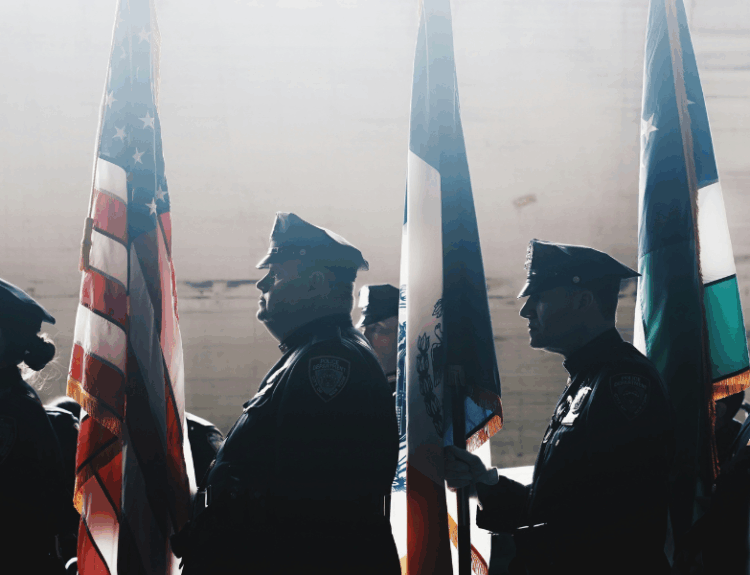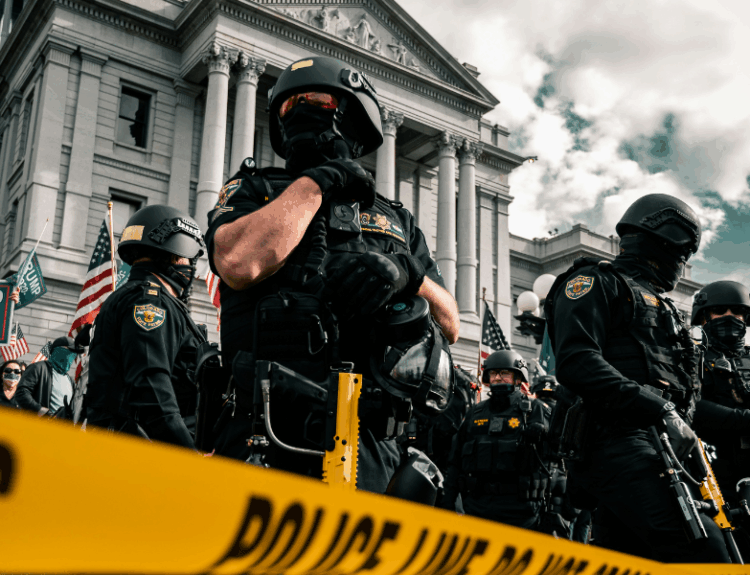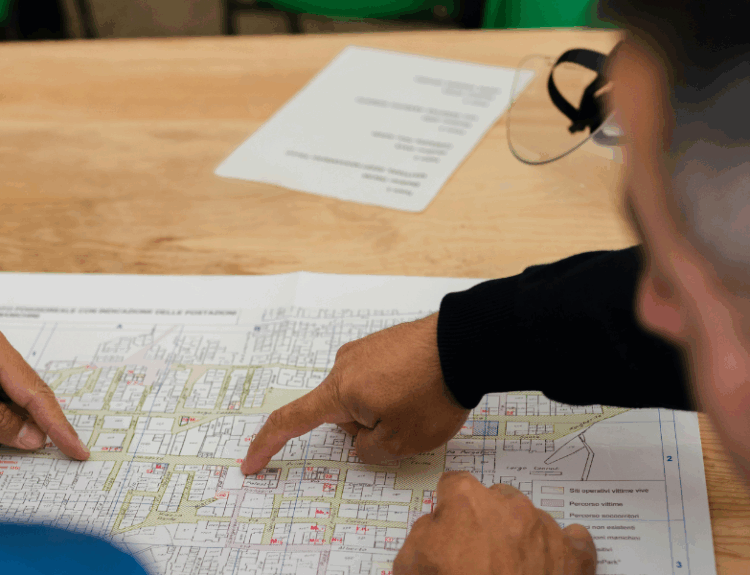The precedence for public safety has always been the top concern in the U.S. bureaucracy; thus, to ensure excellence in public safety and security, the U.S. Bureau of Labor Statistics anticipates the addition of over 50,000 new police officer positions to serve the cause of public safety by 2032. Considering the heightened risk of security and the provision of a safe environment for the public, an exigency for dedicated and qualified officers, ready to protect and serve, has increased twofold. If you’re looking forward to joining the U.S. police force, you’re in the right place.
Law and order institutions in the U.S. are not only subjected to black and white rules; ergo, holding a position in the U.S. police department is not just limited to the uniform and discipline. It is a comprehensive and structured process, including the specific criteria for qualifications, getting accepted through the entrance exam, and completion of extensive academy training. Whether you’re a recent high school graduate or looking for a career shift, this guide helps you understand the key requirements as you need to take a step forward in U.S. police education— the right way.
Key Takeaways:
- There’s a strong and extensive set of criteria that must be met if you want to become a police officer in the U.S. From the basic written and physical exams to undergoing psychological and background checks as well as completing the intensive 6-24 months training from the police academy; you’ve to prove your worth before selection.
- Most states in the U.S. have set their age requirements between 18 to 21 years with a mandatory requirement of a high school diploma or GED. However, states like New York give preference to military experience or college credits for high-end, competitive positions.
- Applicants enrolling to become a police officer must be U.S. citizens or carry a lawful permanent residency. It is because federal agencies like the DEA and FBI have mandated U.S citizenship for whatever position you might be enrolling. It is essential to have a clean criminal record as well.
- Candidates must pass the medical screenings, fitness tests, and psychological evaluations to ensure mental stability and physical readiness during high-pressure law enforcement duties.
- With around 50,000 new positions projected in the police department of the U.S. by 2032 and an average salary hitting $74,000/annum, law enforcement certainly offers a purpose-driven, secure career, specifically for those skilled in leadership, forensics, and cybercrime.
Do You Have What It Takes to be a Police Officer? The Bare Minimum Requirements
As with any specialized career, police education in the U.S. also has certain criteria for eligibility, which aspirants have to meet before enrolling or starting the application process in the police academy. The requirements may slightly vary based on the policies of different states or departments; however, the common guidelines followed by the U.S. law enforcement agencies are mostly similar. Here’s the detailed breakdown of the core prerequisites one needs to meet to qualify for the enrollment process in the U.S. police academies.
1. Police Officer Age Requirements by State
The factor of age is critical in the police profession. The most common question that aspirants want to ask is:
“What is the maximum age limit that is allowed to become a police officer as per the U.S laws?”
In general, the applicant must be at least 18 to 21 years old, which may sometimes vary from one state to another. In most of the U. S police academies, a candidate with a high school diploma (age as young as 18 years) is allowed to enroll as a police officer trainee, while other schools have a minimum age limit of 21 years, specifically if you’re applying for the services with firearm responsibilities.
Here’s a quick overview of the minimum and maximum age brackets as required by police academies in three major US states:
| State | Minimum Age | Maximum Age |
| New York | 21 | 35* |
| California | 18 | None (but must meet physical standards) |
| Florida | 19 | None (depends on department policy) |
| Texas | 21 | None |
| Michigan | 21 | None |
*It is noteworthy that police academies in New York have a maximum age limit of 35 years; however, veterans may qualify for age waivers up to certain limitations.
2. Education Requirements
If you are looking for an answer about,
“What is the minimum qualification required to get enrolled in the U.S police academies?” Here are the answers.
As the minimum requirement in most of the U.S law enforcement departments, a high school diploma or GED is needed to qualify for the application process. However, those who have college records with coursework in the related subjects, such as criminal justice, etc, or degrees may get higher priority and pose high-level competition over the others. Thus, it is worth taking a police coursework in criminal law, Ethics, community policing, or conflict resolution after a high school diploma, if you are planning to get yourself enrolled as a police officer.
In most cases, aspirants also get themselves enrolled in a police course at the college level or two-year associate level programs before applying to the police academy to get an academic edge among the other aspirants. Some of the common educational options include:
- Community colleges that offer courses in police education with a specific focus on academy prep.
- State universities that offer associate-level degrees in criminal justice
- Certificate programs for special law enforcement tracks
3.U.S. Citizenship and Residency Requirements
“Is it possible for non-U.S. citizens to become a police officer in the USA?”
The simple and short answer is, it depends.
Immigrants in the U.S. who are planning their career moves in law enforcement agencies often wonder if policies allow non-U.S. citizens to join police forces. In most of the U.S states, strong policies are enforcing strict criteria for an aspirant to be a U.S citizen or at least own a permanent residency with a legal work permit to join a police academy. However, in other states, the policies may vary slightly.
If you do not own U.S citizenship or a PR and are planning for a career move in law enforcement agencies, it is noteworthy that:
- In some of the U.S. states, Green card holders are eligible to apply for police academies
- Non-U.S. citizens with military backgrounds may get some edge in certain law enforcement departments.
- Federal agencies such as, FBI or DEA have strict criteria for the aspirant to be a U.S. citizen.
Nevertheless, if you’re interested in becoming a part of the U.S. police force, check for the following:
- City-specific police department requirements
- Military-to-law enforcement transition programs
- Immigration paths that lead to lawful employment in public safety
With the detailed overview of the eligibility criteria that develops understanding of how to check for your eligibility in the US police force before actual enrollment, moving forward to the actual process of how one should enroll to become a police officer in the USA, stating the key requirements for exams, background checks, and physical testing.
Meeting the standard criteria such as educational requirements, clearing physical testing and background checks, etc. is critical to enroll for the position of a police in the U.S. Once you’ve attained that, the next step is to understand how to become a police officer as explained below.
Step-by-Step Guide on How to Become a Police Officer
This section guides you through the actual steps entailed in securing enrollment in a police academy to become a police officer in the U.S. The process may last up to a minimum of 6 months to 2 years, depending on the state you’re living in, level of education, and the specific requirements of the police department you’re applying to
Step 1: Meet Basic Eligibility Criteria
To begin with the application process, you are advised to check the requirements of age, education, legal, and physical requirements as discussed in the previous section.
Checklist:
- U.S. citizen or lawful permanent resident
- High school diploma or GED (college preferred)
- No felony convictions
- Valid driver’s license
- Minimum age (18–21, depending on the state)
Step 2: Take and Pass the Police Officer Exam
Once you meet the aforementioned criteria for eligibility, you’re required to pass the police officer entrance exam. This standardized test is designed to evaluate the key abilities of the aspirants, such as aptitude, judgment, communication skills, and problem-solving strategies, as needed for competencies in the field.
What’s on the police officer exam?
In general, the police officer entrance exam comprises five basic sections with a varied number of questions in each section. The sections include:
- Reading comprehension
- Writing & grammar
- Situational judgment
- Report writing
- Basic math and logic
However, some other states may include:
- Personality assessments
- Ethics questions
- Memory or observation tests
Point to be noted: To get through the police officer exams with flying colors, aspirants may take help from study material and practice tests available on different police department websites or third-party prep services.
Step 3: Background Investigation & Psychological Screening
Passing the police officer entrance exam is just the first step towards actual enrollment. Aspirants who have cleared the entrance exam have to undergo a comprehensive process of background check and investigation, where the respective departments are hired to check and verify your:
- Criminal record
- Employment history
- Driving record
- Credit history
- Social media presence
Later, the aspirants will have to take a psychological evaluation to determine their mental health and fitness to qualify for the high-stress career in law enforcement agencies. The results are based on several verifications stating the details of offenses, if any, and behavioral checks at different levels, and aspirants can be disqualified if found guilty or accused. However, if the candidate meets all the requirements and is honest during the process, there are high chances of moving forward with the enrollment process.
Step 4: Pass Physical Fitness and Medical Exams
Another milestone to get enrolled in the police academy is to meet the physical requirements. The physical fitness test is designed to check for strength, endurance, and agility in aspirants, considering the critical and stressful situations that police officers have to deal with during their duty hours.
The Common physical test elements:
- 1.5-mile run (timed)
- Push-ups & sit-ups (based on age/gender)
- Vertical jump
- Obstacle course or agility drill
You’ll also go through:
- Vision & hearing test
- Drug screening
- General medical exam
However, the standard benchmarks for physical testing may vary from department to department, but good fitness scores may give an edge in getting enrolled in the police academy among aspirants.
Step 5: Enroll in Police Academy Training
Once the aspirants are marked qualified for the prior stages, a conditional offer or acceptance letter is presented to the aspirants to join a police academy. This is where the journey of enrollment has come to an end, and the real law enforcement training begins.
Duration: Usually stretches between 13 to 36 weeks (full-time)
Type: Classroom learning + physical drills + real-world simulations
Learning goals :
- Criminal and constitutional law
- Firearms training
- Traffic laws and DUI enforcement
- First aid/CPR
- Defensive tactics
- Report writing
- Ethics and community policing
In the USA, some police academies are operating separately as standalone institutions; however, others have their affiliations with community colleges that offer full-time associate-level police courses or degrees. It is noteworthy that the successful completion of academy training doesn’t lead the full-time employment in the police service department, but it is considered the core requirement for aspirants seeking a career in the law and enforcement agencies in all 50 states of the U.S.
The academy graduates are required to move towards the field training, which eventually leads them to full-time employment, but the overall process may vary depending on the specific policies of different U.S. states. In the next section, we’ll highlight the specific requirements about how to become a police officer in the three major states of the USA, i.e., NY, California, and Florida.
State-Specific Enrollment: NY, CA, FL
The law enforcement agencies in the USA follow a similar process of enrollment across various states; there may be a certain set of rules that are specific to each jurisdiction regarding the eligibility criteria, education, and training of police officers. Aspirants are often confused about such requirements in different states.
State-Specific Enrollment Overview
| State | Minimum Age | Education Requirement | Key Exam | Training Duration | Governing Body |
| New York | 21 | 60 college credits or military | NYPD Entrance Exam | ~26 weeks | DCAS / NYPD Academy |
| California | 18 | High school diploma or GED | POST Entry Test | 24–36 weeks | California POST |
| Florida | 19 | High school diploma or GED | BAT / SOCE | ~6 months | FDLE / CJSTC |
Sources: golawenforcement.com
Although each state has its own set of rules tailored to the local standards, the key value among all institutions is based on integrity, physical readiness, and community trust—the three foundational pillars that define modern law enforcement in the U.S.
Lets explore the key requirements as depicted by the major academies in the three major states of the U.S. —Newyork, California, and Florida— the most sought-after states’ law enforcement regions in the U.S.
How to Become a Police Officer in New York
The police academies in the jurisdiction of New York are known to be highly competitive and strict with standard requirements, making it comparatively tough for police officer aspirants applying in this region. However, once you’re selected, it offers some of the most highly rewarding career opportunities in public safety.
Key Requirements:
- Age: applicants must be aged between 21 years to 35 years old, with a certain age waiver available for military veterans
- Education: At least 60 credits in college-level education or military service equivalent
- Citizenship: U.S. citizenship is required
- Residency: Must live within New York State or nearby counties (depending on department policy)
Enrollment Steps:
- Check for your eligibility (discussed in previous sections) and apply for the NYPD Police Officer Entrance Exam administered by the NYC Department of Citywide Administrative Services.
- Qualify for Candidate Assessment Division (CAD screening) —including background check, drug test, and psychological exam.
- Once qualified, you’re automatically directed to take the JST (Job Standard Test) — designed to check aspirants’ agility, stamina, and strength.
- If you pass this stage, you will receive an acceptance letter from the NYPD Police academy to attend a 6-month rigorous training program that covers different aspects of law enforcement and public safety, including policing tactics, firearms, and physical conditioning.
Training Duration: Approximately 26 weeks (full-time)
Academy Location: Police Academy, College Point, Queens, NY
How to Become a Police Officer in California
California is known as the critical hub in the provision and maintenance of public safety in the U.S., with some of the most diverse law enforcement agencies practicing and enforcing law across various states, extending from LAPD and CHP (California Highway Patrol) to various small municipal departments.
Key Requirements:
- Age: Minimum age limit of 18 years (some agencies prefer 21)
- Education: High school diploma or GED required; associate degree in criminal justice preferred
- Citizenship: U.S. citizen or permanent resident eligible for citizenship
- Background: No felony convictions and strong moral character.
Enrollment Steps:
- After checking for the eligibility criteria, apply for the POST (Peace Officer Standards and Training) entry-level Law Enforcement Test Battery, comprising sections to check for reading, writing, and reasoning skills of the aspirants.
- Once qualified, you will be asked to complete the Physical Agility Test (PAT) and the Background Investigations.
- Undergo medical and psychological evaluations.
- If you’re selected, you will be asked to attend POST-certified police academy training, which usually lasts for 6-9 months. The training consists of different modules, including classroom training, defensive tactics, handling of firearms, and patrol simulations
Training Duration: 24–36 weeks, varies from academy to academy
Notable Academies: Los Angeles Police Academy, San Diego Regional Academy, Golden West College Police Academy
How to Become a Police Officer in Florida
Academies in Florida have well-structured programs for aspirants to become certified police officers, which are primarily administered by the Florida Department of Law Enforcement (FDLE) standards.
Key Requirements:
- Age: Minimum 19 years old
- Education: High school diploma or equivalent; college coursework optional but beneficial
- Citizenship: U.S. citizenship is a must.
- Residency: Must be eligible to work in Florida and meet FDLE certification standards
Enrollment Steps:
- Check for eligibility criteria and apply the BAT (Basic Abilities Test), specifically designed to measure language skills, reasoning, and situational judgment among students.
- Once cleared, you need to take the CJSTC (Criminal Justice Basic Abilities) Police Academy, administered by the FDLE.
- After qualifying for CJSTC, you will be asked to join the academy training (typically consisting of 770 hours), including the comprehensive hands-on training of firearms, defensive tactics, and emergency vehicle operations.
- After the completion of academy training, you’ll be eligible to take the SOCE (State Officer Certification Exam).
Training Duration: Around 6 months
Academy Examples: Miami-Dade Police Academy, Broward College Institute of Public Safety
Federal Law Enforcement Pathway
If you’re aiming to get a high level of excellence in your career as a police officer, a federal law enforcement career offers opportunities for national-level service in top U.S. agencies like the FBI, DEA, or U.S. Marshals Service.
Requirements:
- U.S. citizenship
- Minimum age 21
- Bachelor’s degree
- Background and polygraph clearance
Training:
Aspirants who have been recruited by the federal law enforcement agencies are invited to attend the specialized training at the Federal Law Enforcement Training Center, which lasts approximately 14-26 weeks. The key elements of training include federal law, firearms, investigation techniques, and counter-terrorism.
What to Expect on the Job
Depending on the level of entry, your core responsibilities may vary from day-to-day activities in policing or it may be at the desk writing reports and managing the crew. Here are some, an overview of what to expect on your initial days and the skills required to succeed.
Core Duties
- Patrol neighborhoods and respond to emergencies
- Investigate crimes and file reports.
- Enforce traffic laws
- Testify in court
- Engage in community outreach
Essential Skills
- Strong communication
- Ethical judgment
- Physical fitness
- Emotional resilience
- Quick, rational decision-making
Salary and Career Outlook
As per the recent data of the BLS, the median annual salary for police officers in the U.S. is around $76,550, with pay ranges between:
- Average Salary In California: $ 111,770/annum
- Average Salary In New York: $89,400/annum
- Average Salary In Texas: $73,600
- Average Salary in Florida: $78,480
Job Growth: As discussed previously, the U.S. police departments are expected to enroll 50,000 new officers by 2032, ensuring consistent opportunities nationwide. However, the officers having key skills in cybercrime, data analysis, or forensics may get a new edge and faster career advancement into specialized or leadership roles.
Finally, Is a Career In Police Right for You?
If you’re planning a career as a police officer in the U.S., it is noteworthy to know that it is not just going to be a job decision, but a lifelong commitment to police service, integrity, and community protection. Although the journey seems comparatively demanding, from meeting the basic criteria of selection, strong fitness standards, and entrance exams, to completing the rigorous police academy training; however, the future depicts rewarding and promising outcomes.
So, f you believe in value discipline, teamwork, and making a change, the U.S. law enforcement agencies offer continuous growth and ample opportunities to build a stable and purpose-driven career in public safety. You can simply begin by researching the right requirements as defined by the law enforcement institutions in your state, prepare vigorously for exams, and maintain a high level of physical fitness.







